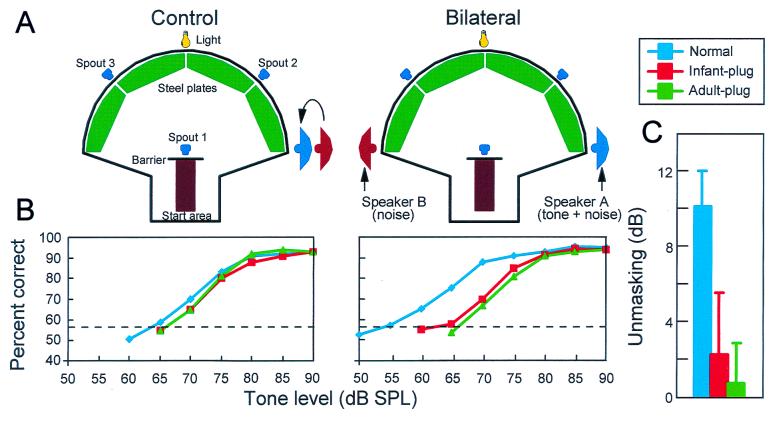Figure 7.
Effect of chronic monaural occlusion on binaural unmasking in ferrets. (A) Adult ferrets were trained to detect a 500-Hz tone (delivered from speaker A) in the presence of a noise (delivered from speakers A and B) when a light flashed. The noise stimuli were presented continuously. On 50% of trials, a tone was presented when the ferret contacted spout 1. Success in the task was measured by the ferret correctly identifying the presence or absence of the tone (by going to spouts 2 or 3, respectively). In the control condition (tones and noise interaurally in phase), both speakers were positioned on the ferret's right side. In the bilateral condition, the noise was made out of phase with the tone by moving speaker B (noise alone) to the ferret's left side. The difference in tone threshold between the two conditions measured binaural unmasking. (B) Ferrets learned to perform this task at a high level; the dashed line shows performance that was statistically above chance (binomial distribution). However, normal ferrets, like normal humans (Fig. 6), consistently produced thresholds that were about 10 dB better in the bilateral condition, showing binaural unmasking. (C) After 3–12 months of unilateral (left) ear plugging, there was little or no difference in performance between the control and the bilateral conditions, while the plug was in place. This lack of difference was true both for ferrets plugged before the normal onset of hearing (Infant-plug) and for ferrets receiving equivalent experience in adulthood (Adult-plug). Note, however, that one of the four infant-plugged ferrets had 8 dB of residual unmasking. When the plug was finally removed, both groups had impaired unmasking, despite normal pure tone sensitivity in the previously plugged ear. Like humans who have had surgery for a conductive hearing loss (Fig. 6), the unplugged ferrets gradually recovered normal binaural unmasking over a period of several months (from ref. 54).

